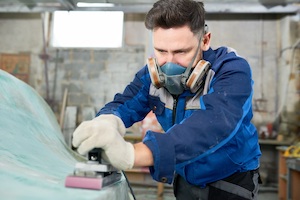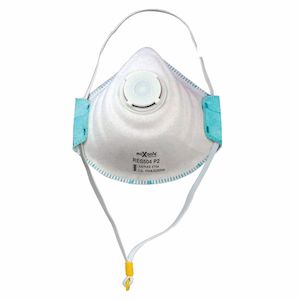Benefits of P2 Respirators
Date Posted: 30 January 2020
 Respirators are a vital piece of personal protective equipment (PPE). People who are continually exposed to hazardous elements and environments should wear them.
Respirators are a vital piece of personal protective equipment (PPE). People who are continually exposed to hazardous elements and environments should wear them.
The right respirator or safety mask can provide the protection needed from dust particles, as well as smoke, fumes, and chemicals.
Many airborne contaminants can pose a great risk to our health. One way to protect respiratory health is through the use of particulate disposable respirators.
A Little Bit of Backstory about Particulate Disposable Respirators
Commonly called P1, P2, and P3, these filtering face masks or respirators are the most uncomplicated and most affordable types of respirators that you can find. They are effective in protecting users against airborne particles, such as fumes, mist, and dust.
The dust masks have many applications. Many industries use them to prevent contaminants from irritating the respiratory system. Healthcare facilities and construction companies usually make sure that the workers use disposable particulate respirators while on the job.
The primary function of the masks is to purify the air particles, so you breathe in clean air.
What are P2 Respirators?
 Compared to surgical masks, P2 respirators are more effective. They are among the best-selling dust masks, especially with the bushfires plaguing the country right now.
Compared to surgical masks, P2 respirators are more effective. They are among the best-selling dust masks, especially with the bushfires plaguing the country right now.
Many healthcare facilities still use surgical masks, which are designed to keep patients from getting exposed to the saliva and other respiratory secretions of the doctor or the wearer. It should be noted that this type of mask does not do anything to protect the wearer against any chemical or particle exposure.
Another extremely popular mask today is a P1-rated respirator. It is useful in protecting the wearer against insignificant levels of dust. Many people utilise this respirator daily, when commuting, for instance.
The problem with P1-rated respirators is that they only retain about 80% of tiny particles. If the particle is less than two micrometres, it will not reach the other side of the mask.
On the other hand, P2-rated respirators can prevent about 94% of particles. These particles can be as small as 0.5 micrometre. It is why these dust masks are effective when used in an area where mechanically-generated particles are abundant.
If you are exposed to mists, vapours, and fumes in the course of your work, the best type of face-piece to go for is a P2. Welders, gardeners, and painters should use P2 respirators.
When Should You Use P2 Respirators?
If you work in hospitals, the P2 mask is the best option for you. It is especially true if you will not be exposed to certain chemicals that can be dangerous to your health.
Aside from those who work at healthcare facilities, the masks are also excellent for use at the following industries:
- Mining
- Steel fabrication
- Woodworking
- Metalworking
Those who work in the chemical industry can also use P2 respirators. However, some chemicals, which are listed below, are dangerous and may need more intense protection:
- Arsenic
- Cobalt
- Radium
- Nickel
- Strychnine
- Antimony
- Beryllium
Any place where radioactive particles are present requires P3-rated respirators.
What Are the Benefits?
In some places, P2 masks are known as N95 masks. The difference between these two is that the N95 has passed the US testing standards. Nevertheless, many people use the terms interchangeably, which is acceptable.
Using a P2 respirator offers several benefits, including:
- The respirator is effective in filtering out fine particles. These particles can cause allergies, coughs, difficulty in breathing, and other respiratory problems. They should not be inhaled to protect the body.
- P2 masks help reduce exposure to poor air quality. It may be due to bushfire smoke, which can have associated health risks when the nose and mouth are continuously bare.
- It is easy to find P2 respirators. The Grit has many choices available, such as MaxiSafe and SafeCorp.
- The masks are designed with a very close fit to the face of the wearer. Make sure that it seals the bridge of your nose and the whole mouth. There should be no gaps between the face and the mask. P2 is comfortable even when worn for several hours.
- The masks can be used in areas with welding fumes and other thermally or mechanically generated particles.
- For those working in the hospital or clinics, they can use the masks to protect them against specific biological particles from SARS or tuberculosis.
- When you use the P2 respirator correctly, you can gain all the benefits above and more. It has higher protection than P1 masks, protecting you against low to moderate levels of dust and other particles.
- Respirators are for everyone. You do not have to work in a hazardous workplace to use the mask. If you have respiratory problems, including lung disease and asthma, you should have P2 ready at all times. Doctors also recommend using P2 respirators for people who have diabetes. Obese individuals should also have P2 masks.
- Families should take care of everyone, especially children and the elderly. If you have been diagnosed with cardiovascular disease, you will benefit from P2 respirators as well. Women who are expecting, as well as lactating mothers, should wear the mask as much as possible.
P2 Respirator Buying Guide
Before you purchase a P2 respirator, you should bear in mind that it can protect you against tiny particles that could harm your respiratory health. However, it is not designed to keep you safe from chemicals and toxic vapours.
If you will be exposed to thinners, glue, paint fumes, or carbon monoxide, P2 is not for you.
With these things in mind, here are some considerations when you are in the market for a P2 respirator:
- It should comply with the necessary rules and standards.
- Everyone should take PPE seriously. You cannot purchase a cheap surgical mask when you work in any of the industries mentioned above. Therefore, you should wear the appropriate dust mask, whether at work or whenever you need it.
- The mask should comply with specific standards, especially AS/NZ 1716:2012, which governs respiratory protective devices. The dust masks should also meet the European testing requirements.
- Go for a respirator with a valve.
- The longer you use the masks, the more particles are trapped outside it. Therefore, it can get harder for you to breathe over time. You need to replace it before it absorbs too much dust. Another solution is to buy a respirator that has an exhalation valve. This type of P2 respirator can help improve comfort and effectiveness. One example is Maxisafe’s version of the P2 safety dust mask. It comes with a valve, which makes it more comfortable and convenient, thanks to the increased airflow.
- Also, check out Safecorp and its disposable P2 face mask that comes with both a valve and filter. This mask is excellent for those who get exposed to mist and dust, such as welders and farmers applying chemicals to plants.
- The valve works to let carbon dioxide escape. Therefore, you have a mask that you can safely and comfortably wear when you need it.
- Choose a comfortable respirator.
- You should only use a mask that fits your face correctly. It should not slide down or move when you are wearing it. A snug fit is recommended at all times, especially when exposure is taking place.
Need a P2 respirator mask? Check out The Grit’s collection of the best respirators around.
